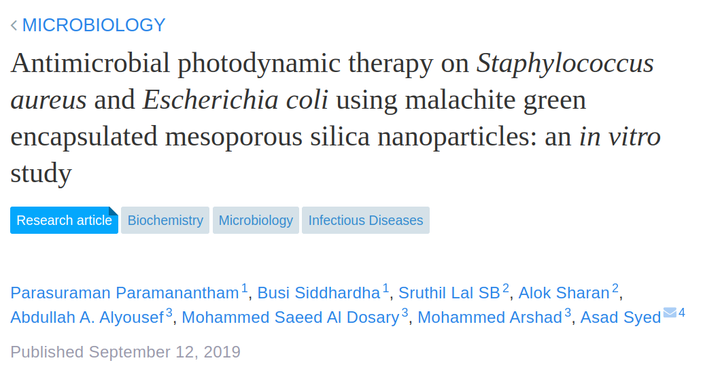Antimicrobial photodynamic therapy on Staphylococcus aureus and Escherichia coli using malachite green encapsulated mesoporous silica nanoparticles: an in vitro study
 PeerJ, 7, e7454
PeerJ, 7, e7454
Abstract
Rise in the number of healthcare associated or hospital acquired infections is a major problem affecting the global healthcare sector. We evaluated superior antibacterial and antibiofilm photodynamic therapy (aPDT) using malachite green encapsulated mesoporous silica nanoparticles (MG-MSN) against Staphylococcus aureus and Escherichia coli, which are known to be major causative agents of nosocomial infections. Malachite green (MG) was encapsulated on mesoporous silica nanoparticles (MSN). Fourier-transform infrared spectroscopy, Transmission electron microscopy, and spectroscopic analysis were performed to characterize the MG-MSN. The antimicrobial efficacies of MSN, MG, and MG-MSN were investigated and the results were recorded. MG-MSN was effective against both the tested bacteria. S. aureus was more phototoxic to MG-MSN compared to E. coli. The antibiofilm efficacy of MG-MSN on E. coli and S. aureus was also studied. Biofilm inhibition was 65.68 ± 2.62% in E. coli and 79.66 ± 3.82% in S. aureus. Cell viability assay, exopolysaccharides quantification, and confocal laser scanning microscopy studies also revealed the enhanced antibiofilm activity of MG-MSN when used as a potential photosensitizer for aPDT. This study can be extended to eradicate these strains from localized superficial infections and medical appliances, preventing nosocomial infections.Infections associated with medical devices that are caused by biofilms remain a considerable challenge for health care systems owing to their multidrug resistance patterns. Biofilms of Pseudomonas aeruginosa and Staphylococcus aureus can result in life-threatening situations which are tough to eliminate by traditional methods. Antimicrobial photodynamic inactivation (aPDT) constitutes an alternative method of killing deadly pathogens and their biofilms using reactive oxygen species (ROS). This study investigated the efficacy of enhanced in vitro aPDT of P. aeruginosa and S. aureus using malachite green conjugated to carboxyl-functionalized multi-walled carbon nanotubes (MGCNT). Both the planktonic cells and biofilms of test bacteria were demonstrated to be susceptible to the MGCNT conjugate. These MGCNT conjugates may thus be employed as a facile strategy for designing antibacterial and anti-biofilm coatings to prevent the infections associated with medical devices.